Guaranteed 12/24 Delivery Still Available see item page for details! available on most items - Details
How to Install a Maximum Motorsports IRS Rear Upper Control Arm Delrin Bushing Kit your 1999-2004 Co

Shop Parts in this Guide
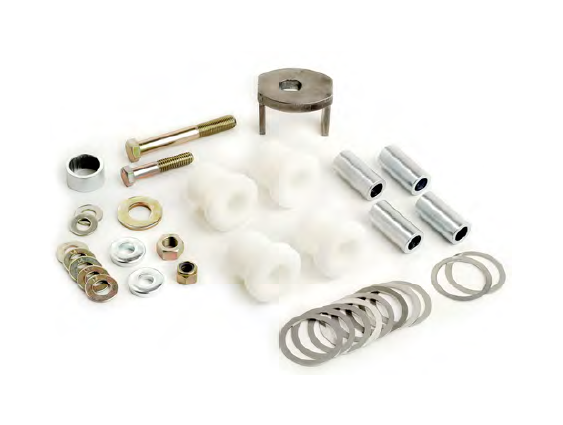
Read all instructions before beginning work.Following instructions in the proper sequence will ensure the best and easiest installation.
Thank you for purchasing the Maximum Motorsports IRS Delrin Upper Control Arm Bushing Kit. This kit will improve handling and reduce wheel hop by eliminating the deflection allowed by the stock rubber upper control arm bushings. The Delrin bushings precisely locate the upper control arms. This maintains rear wheel alignment in a manner that is impossible with the compliant stock rubber bushings. While providing adequate suspension control, noise and vibration reduction, rubber bushings cannot accurately position the control arms well enough to achieve maximum performance from the suspension. Wheel hop is caused by the undamped compression of the rubber bushings in the rear suspension. That undamped movement is further increased by repeated loss of traction. Wheel hop can occur under acceleration or braking. Eliminating the soft stock bushings that compress easily and spring back, causing the tires to continually lose and regain traction, will reduce wheel hop.
There are many unique features to our bushing kit.
• Stainless steel shims are used to custom fit each bushing and arm combination to the subframe, unlike any other kit available. There are large production tolerances in the fore and aft position of the control arm mounting tabs. The distance between the forward and rear most tabs can vary by over 1/4"! This works fine for the pliable factory rubber bushings, but not when trying to improve performance by using precision-machined bushings. This custom fitting process ensures that the control arm cannot shift forward or rearward because of the factory production tolerances. No other bushing kit on the market can accommodate these tolerances, as the MM kit does.
• The Delrin bushing shoulders are chamfered to ease installation, and reduce the sliding-friction contact area with the sub-frame tabs.
• Tooling! We include a set of press tools to remove the stock rubber bushings and shells. There is no need to spend hours at the difficult task of drilling out bushings and cutting up bushing shells. With the MM bushing press tools, all four control arm bushings can be easily removed in a matter of minutes.
• Tab-straightening tools are included with the MM kit to assist in flattening the sub-frame tabs before installing the new Delrin bushings. The mounting tabs are distorted on the assembly line when the control arms are originally installed. This is a critical step that ensures that the control arms pivot freely, without binding.
Besides the typically required hand tools, this installation will require the following items:
• Flat file
• Grease or Anti-seize
• Hacksaw
Remove the IRS Subframe
Follow the attached MM IRS Subframe Removal Instructions to remove the IRS Subframe.
Remove the Upper Control Arms
1. Remove the IRS Upper Control Arms.
Remove Control Arm Bushings
2. Grip the control arm in a soft jaw vise to avoid damaging the arm. Orient it so that one of the bushings is facing upward.
3. Use a hacksaw to cut the bushing flange in the location shown, directly opposite the arm. Be careful not to cut into the control arm.
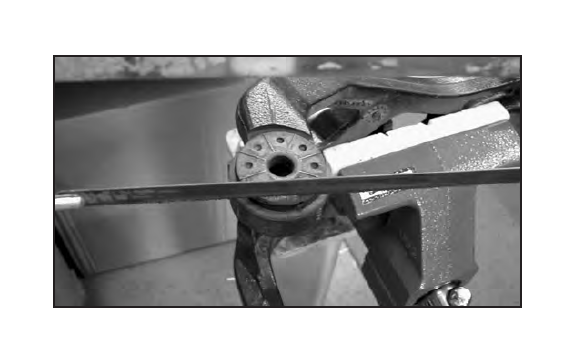
NOTE: There is an upper and lower part of the flange. Cut through both. The photo below shows a removed bushing with the flange properly cut.
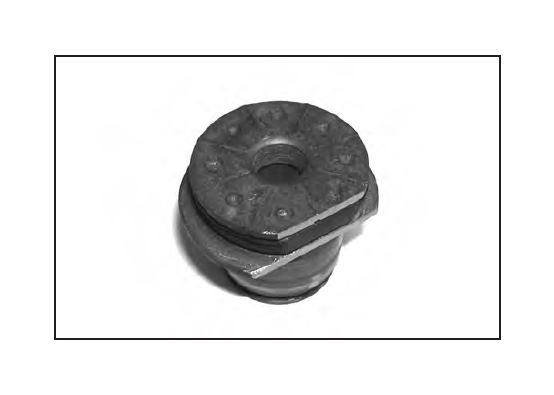
4. Apply a liberal amount of anti-seize compound to the entire threaded portion of the supplied 7/16- 20 x 3-1/4” bolt and 7/16-20 nut.
5. Place one washer under the head of the bolt and insert through the Removal Tool.
6. Apply anti-seize between the washer, the head of the bolt, and the Removal Tool.
7. Place the legs of the Removal Tool across the control arm bushing. The Removal Tool should rest firmly against the control arm.
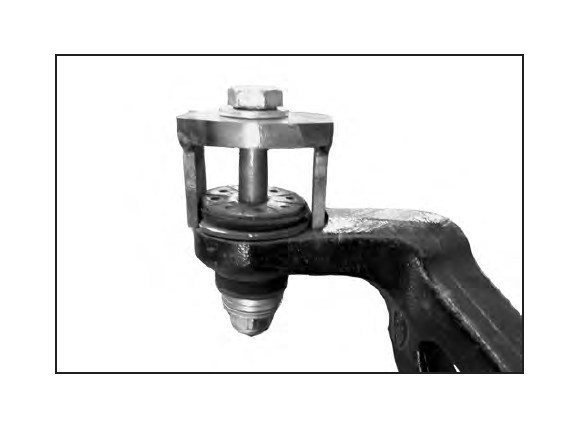
8. Thread the nut and washer on the bolt as shown in the photo above. (Extra washers shown- see note in Step 9)
9. Using a wrench and ratchet, tighten the bolt until the bushing is pulled free of the control arm. The bushing shell only needs to move about 3/4” to become free. To avoid damaging the arm, we recommend AGAINST using an impact gun.
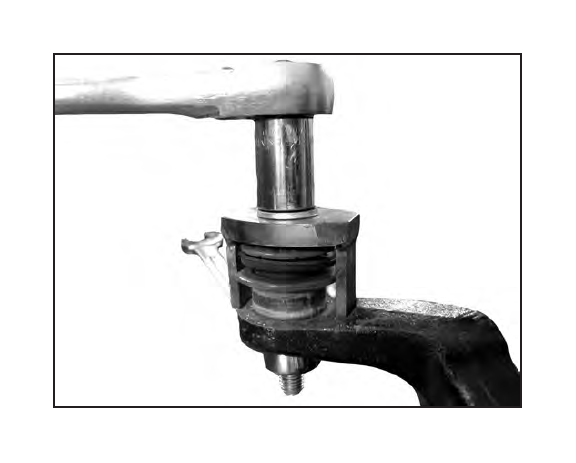
NOTE: It is possible that the nut will bottom out on the threads before the bushing is completely removed. If this happens, place additional 7/16” washers under the bolt head, or under the nut, and repeat Step 9.
10. Repeat Steps 2-9 to remove the other three control arm bushings.
11. Using the supplied Scotch-Brite pad, clean up the dirt and oxidation on the control arms as shown.
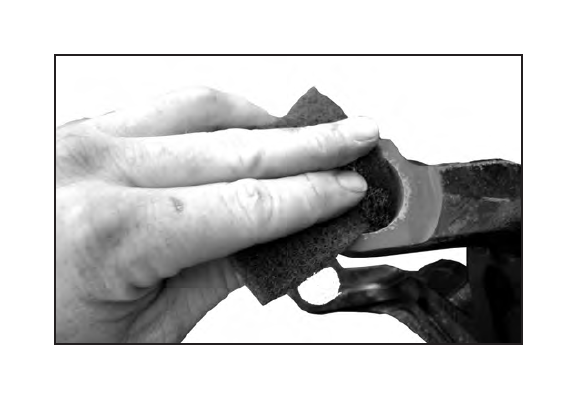
Straightening of Control Arm Mounting Tabs
The control arm tabs are deformed from the control arm mounting bolts being tightened at the factory. Proper tab straightening will minimize bind between the bushing faces and the mounting tabs.
12. Check that a crush sleeve will fit between each pair of control arm mounting tabs. Use a Crescent wrench to spread any overly bent tabs apart until the crush sleeve can be inserted between the tabs.
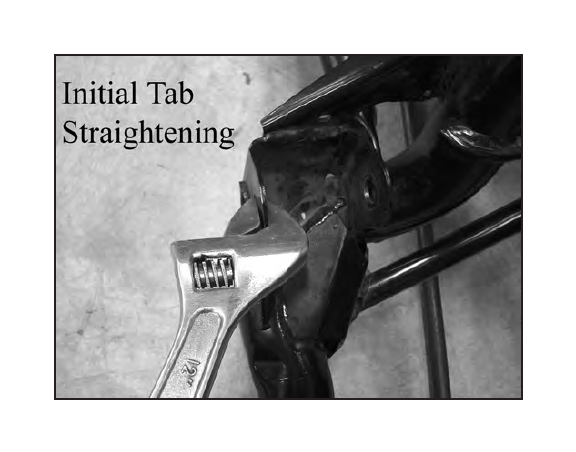
13. Set the Tab Straightening Spacer on the outside of the tab. Place the 3/8 G8 washer, 3/8 thick washer, and 5/8 G8 Washer on the 3/8-16 x 2” long bolt. Run the bolt through and place the other thick washer, 3/8 G8 washer, and nut on the inside of the tab. Use anti-seize compound or grease on the threads and washer surfaces.
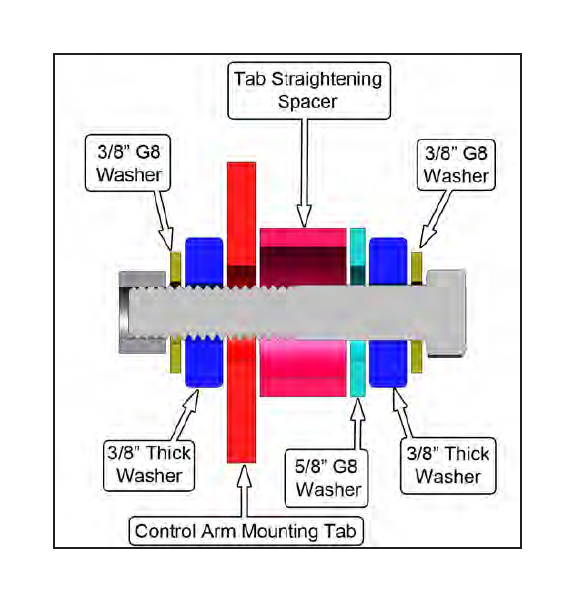
14. Tighten the bolt to pull the tab straight. Be careful to not over bend the tab. It may be necessary to move the setup around and repeat the process to flatten the entire mounting surface.
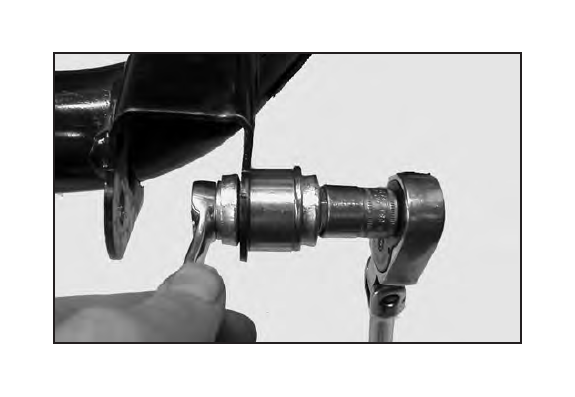
NOTE: To check tab straightness, set the crush sleeve flush against one tab. There should be a uniform gap from the crush sleeve to the tab at the other end. Continue the process until the tabs are straight.
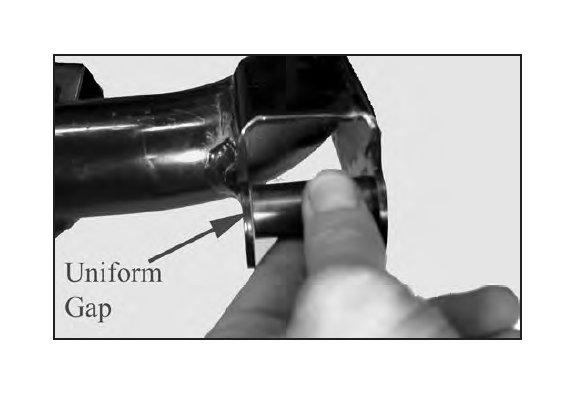
15. At this point, check the inner surface of each control arm mounting tab for irregularities from weld spatter or other protrusions. It is important that the mating area of the Delrin be smooth. Use a flat file to smooth out the area.
Install Bushings
NOTE: Complete the remaining installation steps for the passenger side first, until instructed to work on the driver side.
16. Install the bushings and crush sleeves in the passenger side control arm. The bushing shoulder faces towards the outside of the control arm.
NOTE: Do not grease the bushings yet; they will be lubricated during a later step.
17. Install the arm into the sub-frame. Snug the mounting bolts, but do not fully torque. The arm will be removed again later.
NOTE: You will notice a gap between the bushings and the mounting tabs. This is to be expected, and will be taken up with the shims.
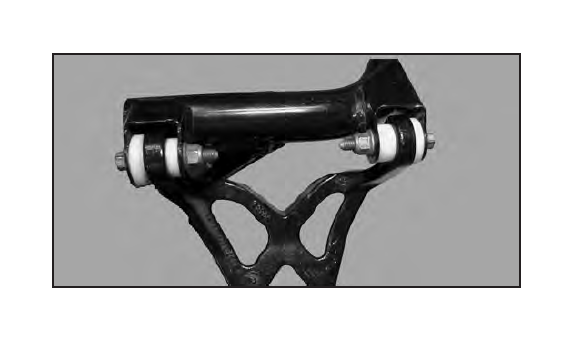
Determine Shim Stack Thickness
18. Push the arm towards the front of the car, so that one side of the arm is flush against the bushing shoulder.
19. Pull the rearward Delrin bushing rearwards, away from the control Arm, until it is resting against the rearward most mounting tab. There is usually a gap between the bushing flange and the control arm.
NOTE: Make sure the control arm is still being pushed towards the front of the car. The goal is to have any gap present at the rear to determine the shim thickness needed.
20. Determine a combination of the thick and thin 1-3/4” outer diameter shims that is wide enough to fill the gap between the rearward control arm bushing and the control arm. You can either measure the gap with a pair of calipers, or stack the shims together and test fit them in the gap.
NOTE: The correct shim stack should fit snuggly into the gap.
NOTE: Only two thin shims are included in this kit. Do NOT use more than one thin shim per side of the vehicle.
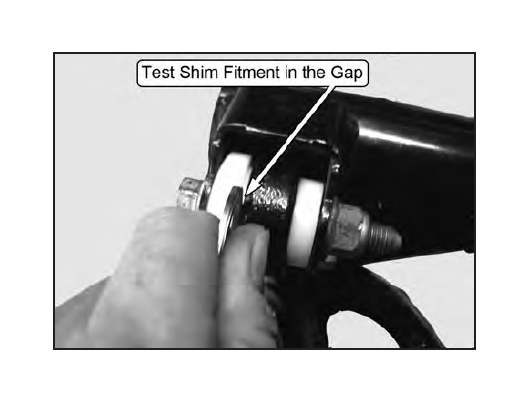
Shim Stack Installation
The goal is to center the arm between the two sets of control arm mounting tabs.
21. Remove the arm from the subframe.
22. Divide the previously determined shim stack in half, one half for the rearward bushing and one half for the forward bushing. If there are an odd number of shims, always place the extra shim in the forward bushing stack.
EXAMPLE: If the installation required 2 thick shims and 1 thin shim, the rearward bushing would receive a thick shim. The forward bushing would receive a thick and a thin shim.
23. Install the shims onto the bushings and insert them into the control arm.
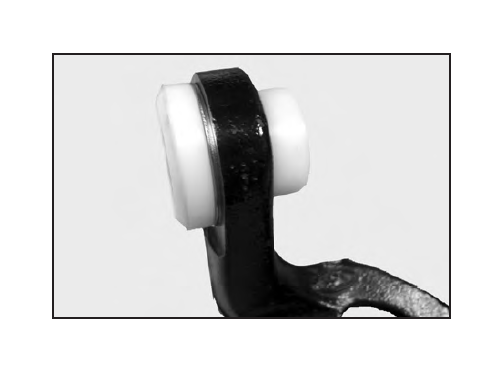
24. Install the crush sleeves and one 1-3/8” Diameter shim around each end of the crush sleeve as shown below. (Control arm removed for clarity)
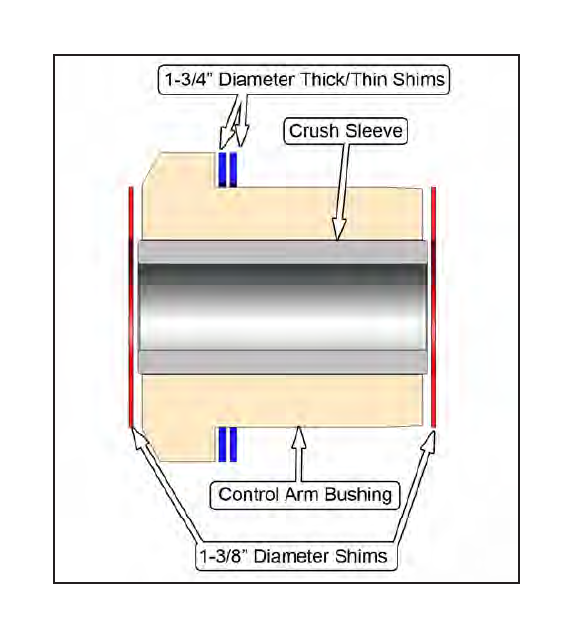
25. Reinstall the arms onto the subframe. Snug, but do not fully torque, the pivot bolts.
26. Check for bind in the system. The upper control arm should pivot freely by hand. If it does not, determine where it is binding and take corrective action.
NOTE: The most likely source of bind is from the control arm tabs not being straightened enough.
NOTE: To determine which pivot bushing is binding up, we recommend loosening one pivot bolt and rechecking for bind. If the bind is reduced, that pivot point needs to be addressed. If the bind isn’t reduced, tighten the bolt and move on to the next pivot bushing and repeat the test procedure.
27. Remove the control arms for final assembly.
28. Remove the 1-3/8” Diameter Shims and the crush sleeves from the control arm.
29. With the supplied grease, lubricate the outside of the crush sleeves, the inside diameter of the control arm bushings, and both faces of the 1-3/8” Diameter Shims.
NOTE: The supplied grease is extremely difficult to remove from your skin and clothing. We have supplied a pair of latex gloves for your protection during lubrication application.
30. Reinstall the crush sleeves and shims onto the control arm.
31. Reinstall the control arm and torque the bolts to 66 ft-lb. Recheck the arms to make sure they still pivot freely.
32. Repeat Steps 16-31 for the driver side.
Reinstall the IRS Subframe
Follow the attached MM IRS Subframe Removal Instructions to reinstall the IRS Subframe (starts at Step 37 of those instructions).
This kit includes:
| Qty | Description | |
|---|---|---|
| 4 | Delrin Bushings | |
| 4 | Crush Sleeves | |
| 8 | Shims, ~1-3/4” Diameter, Thick | |
| 2 | Shims, ~1-3/4” Diameter, Thin | |
| 8 | Shims, ~1-3/8” Diameter | |
| 1 | Tab Straightening Spacer | |
| 1 | 5/8 G8 Wash | |
| 1 | 3/8-16 x 2” G8 bolt | |
| 1 | 3/8-16 G8 nut | |
| 2 | 3/8 G8 flat washer | |
| 2 | 3/8 x 1 x 1/4 thick washer | |
| 1 | Bushing Removal Tool | |
| 1 | 7/16-20 x 3-1/4” Hexbolt||
| 1 | 7/16-20 G8 nut | |
| 5 | 7/16” G8 flat washers | |
| 1 | Small Scotch-Brite pad | |
| 2 | Grease packets | |
| 2 | Latex gloves |
Tech Tip: Some of the Maximum Motorsports products for the Cobra IRS can be installed without removing the complete IRS Subframe unit from the vehicle. However, installation of most items is much easier if the complete IRS unit is removed from the car. With the complete IRS unit away from the car, working conditions are much nicer than working underneath the car. Also, if you install several of the MM IRS products at the same time, the ease of installation becomes even more pronounced. Removal of the IRS Subframe is actually not very difficult, and can be accomplished in one to two hours.
Removal of the complete IRS subframe….
• is required to install the MM Delrin Upper Control Arm Bushings.
• makes it is much easier to install the MM Delrin Lower Control Arm Bushings, and both the MM Aluminum and Urethane Differential Mounts.
• makes it somewhat easier to install the MM IRS Subframe Bushings, and the rear Swaybar Bushings.
• does not help when installing the MM Rear Coil-over Kits, the Adjustable Tie-rod Kit for bumpsteer, or the Adjustable Swaybar Endlinks.
Instructions:
1. Raise the front end of the car by jacking under the center of the K-member. Support it with jack stands positioned under the K-Member right behind the forward front control arm pivot, as indicated by the “X” in the picture below.
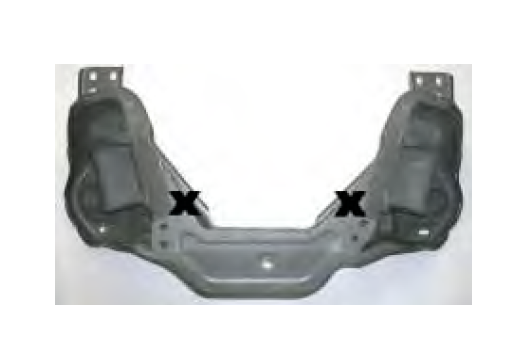
2. Raise the rear of the car with a jack and support the rear of the car on a pair of jack stands. This pair of jack stands MUST be positioned under the chassis of the car (e.g., under aftermarket subframe connectors or under the torque boxes), not under the IRS subframe.
NOTE: To remove the IRS subframe from the vehicle, a minimum distance of 19" is necessary between the ground and the pinch weld seam at the bottom of the rocker panels.
3. Remove the rear wheels.
4. If using control arm mounted springs, mark the orientation of the lower spring ends on the lower control arms.
5. Remove the tail section of the exhaust from the vehicle, disconnecting it at the front of the mufflers. A flat-head screwdriver is useful in prying the rubber exhaust hangers from the exhaust.
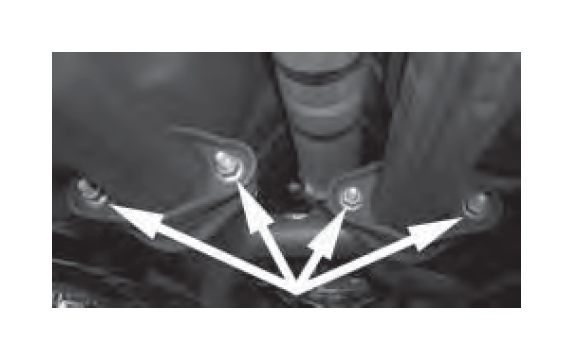
6. Place the jack firmly beneath the passenger side control arm.
7. Remove the passenger side lower shock bolt from the control arm.
8. SLOWLY lower the jack until the control arm is resting on the subframe.
9. Repeat steps 6-8 for the driver side control arm.
10. Mark the orientation of the drive shaft flange to the pinion flange.
11. Remove the four bolts retaining the drive shaft to the pinion flange. It may be helpful to set the parking brake to stop the drive shaft from rotating, or place a pry bar through the U-joint.
12. Using tie wire or zip-ties, secure the drive shaft to the parking brake cable bracket located slightly forward of the rear bulkhead. AVOID removing the drive shaft; doing so will allow oil to drain from around the output shaft of the transmission.
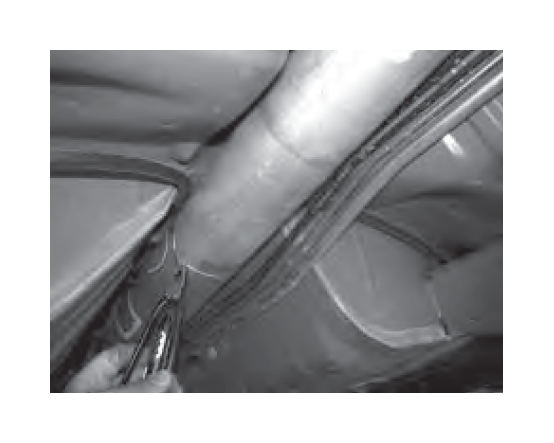
13. Unbolt the parking brake cable mounting-bracket from each control arm.
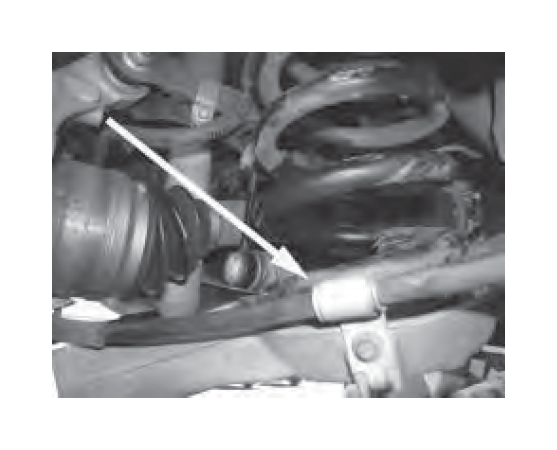
14. Make sure the parking brake is not set, then remove the parking brake cable housing retaining clip on each caliper.
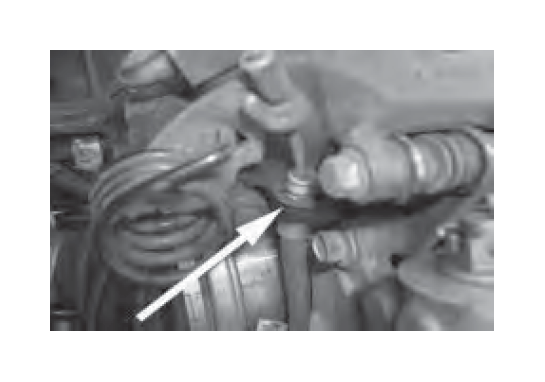
15. Disconnect the parking brake cable from the parking brake lever on each caliper. Remove the cable from the locating hole in the calipers.
16. On 2003-04 vehicles, remove the retaining bolt on each of the brake line locator brackets bolted to the rear upper control arms.
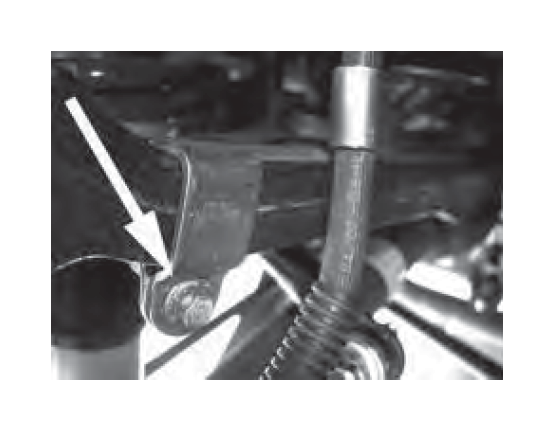
17. On 2003-04 vehicles, remove the brake line locator brackets from the control arms. It will be necessary to spread the bracket legs apart in order to remove them.
18. Using an awl or other sharp object, carefully mark the position of the eccentric camber adjustment bolt on the upper control arms. Aligning these marks during reassembly will help maintain the rear camber setting.
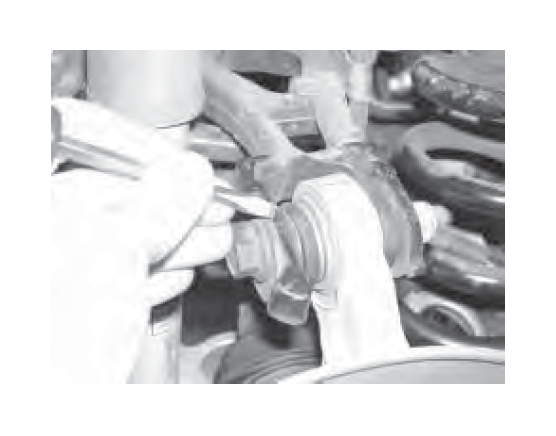
19. Loosen the upper spindle mounting bolt on the passenger side control arm.
20. Remove the two bolts holding the caliper assembly to the spindle on the passenger side. DO NOT allow the caliper to hang by the brake hose. Damage to the brake hose may result.
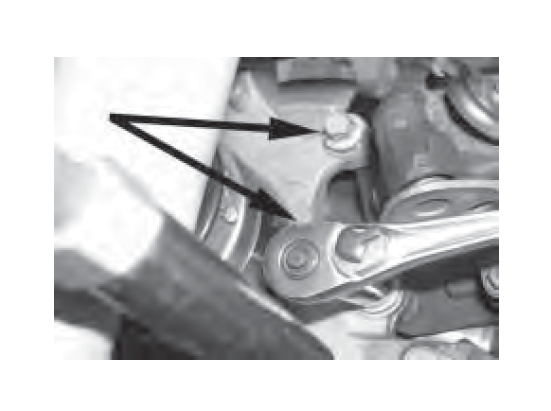
21. Remove the upper spindle mounting bolt.
22. Lift the upper control arm away from the spindle and move the brake line so it is routed above the upper control arm.
23. Replace the upper spindle mounting bolt.
24. Using a zip-tie or safety wire, hang the caliper from the rear chassis mounting bracket for the IRS sub-frame. DO NOT hang the caliper from the subframe.
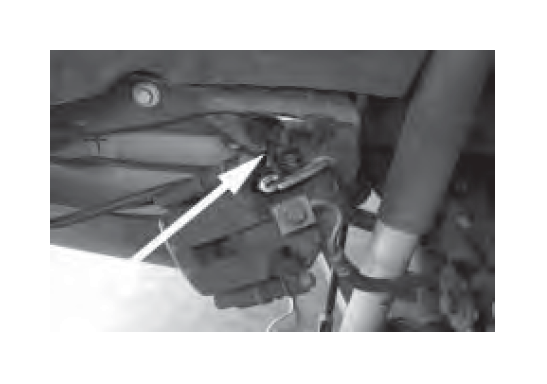
25. Reapeat steps 19-24 for the driver side.
26. Unbolt the ABS sensors from each side of the differential housing and disconnect the plastic retaining clips. These attachment bolts have a head with both an external hex and an internal Torx.
27. Position the jack under the differential and raise the jack until it just contacts the differential. It may be necessary to place a block of wood between the jack and the differential. Be careful not to lift the rear of the car off the jack stands.
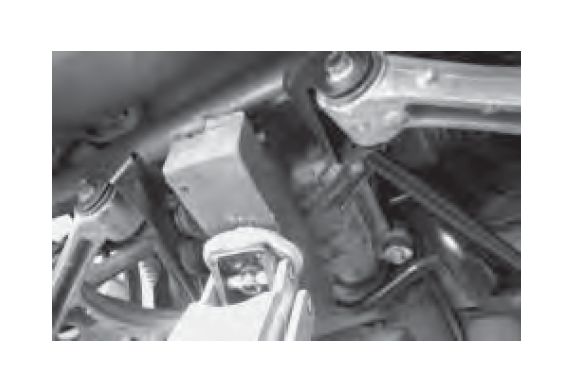
28. Remove the two rear 12mm IRS subframe mounting bolts.
29. Loosen the two forward 14mm IRS subframe mounting bolts.
NOTE: On many factory equipped IRS Mustangs, Ford inadvertently used 12mm bolts to secure the 14mm forward IRS subframe mounts. To prevent excessive movement of the IRS subframe, the proper 14mm factory mounting bolts can be purchased from Maximum Motorsports.
30. Slowly lower the jack, allowing the IRS subframe to pivot about the forward mounting bolts, until the springs are uncompressed.
31. Remove the rear springs from the control arms.
32. Raise the jack up until the IRS subframe is level again.
33. Remove the two forward IRS subframe mounting bolts. It may be necessary to have a friend stabilize the subframe to stop it from falling down upon removal of the forward mounting bolts.
34. Slowly lower the IRS subframe to the ground.
35. Pull the IRS subframe out from under the car.
36. Your IRS subframe is now ready for installation of any of the MM IRS products. Re-install IRS Subframe
37. Position the IRS subframe beneath the vehicle with a floor jack placed beneath the differential. It may be necessary to insert a block of wood between the differential and the jack.
38. Raise the IRS subframe into position and reinstall the two forward 14mm subframe mounting bolts and nuts. 39. Slowly lower the jack until the springs can be inserted.
40. Insert the factory location springs, being sure to orient the spring ends and rubber isolators according to the marks made in step 4.
41. Jack the rear of the IRS subframe up into position.
42. Install the two rearward 12mm IRS subframe mounting bolts.
43. Torque each of the four IRS subframe mounting bolts to 76 ft-lb.
44. Reinstall the ABS sensors onto the differential housing being sure to attach the wires the their respective retaining clips. Torque the Torx bolts to 5 ft-lb.
45. Temporarily remove the upper spindle mounting bolt on each control arm.
46. On each side of the vehicle, lift the upper control arm away from the spindle and move the brake line back into the stock location routing, below the upper control arm.
47. Replace the upper spindle mounting bolt on each side of the vehicle.
48. Reinstall the brake calipers. Torque the caliper mounting bolts to 76 ft-lb.
49. On 2003-04 vehicles, replace the brake line locator brackets back onto the upper control arms.
50. On 2003-04 vehicles, insert the mounting bolt back into each of the brake line locator brackets and tighten until the bracket’s legs are touching.
51. Use the marks previously made on the eccentric cam alignment bolts to realign them. Torque the bolts to 66 ft-lb.
52. Reinstall the parking brake cable onto the parking brake lever on each caliper. Reinstall the parking brake cable housing retaining clip.
53. Reinstall the parking brake cable mounting bracket to the lower control arm and torque the bolt to 9 ft-lb.
54. Connect the drive shaft to the differential. Use the mark made in Step 10 to correctly orient the drive shaft. Torque the bolts to 83 ft-lb. Set the parking brake or use a pry bar through the U-joint to stop the drive shaft from rotating while tightening the bolts.
55. Use a jack to raise passenger side control arm until the lower shock bolt can be inserted. Place the factory nut on the bolt.
56. Torque the lower shock mounting bolt to 98 ft-lb.
57. Repeats steps 55-56 for the driver side control arm.
58. Reinstall the exhaust system and torque the exhaust flange bolts to 34 ft-lb.
59. Reinstall the rear wheels and torque the lug nuts to the manufacturer’s specifications.
60. Safetly lower the car to the ground and test drive. 61. Re-torque the four subframe mounting bolts after 1000 miles of driving.
